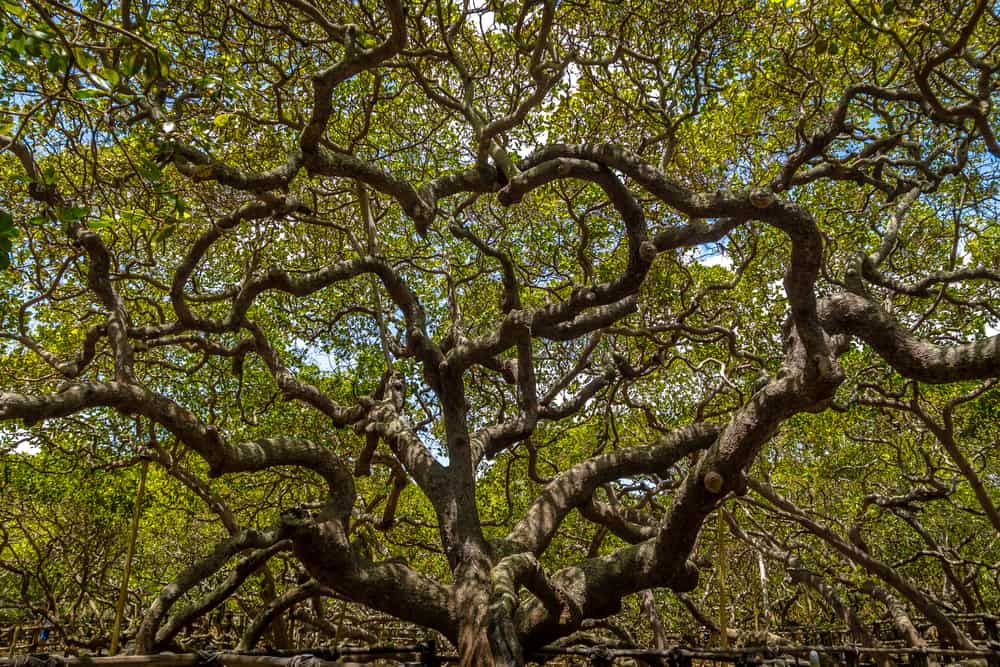
If you’re a lover of whole cashews, you may know a little bit about where your delicious snack comes from. Cashews grow on trees in a handful of tropical climates around the world that are uniquely suited for producing the delicious nut. The tree that produces whole cashews from its cashew apple typically grows up to 46 feet, with most profitable cultivars topping out around 20 feet high.
So you can imagine how unique the world’s largest cashew tree must be when it stands at the size of 70 normal cashew trees put together! This incredible attraction – called the Cashew of Pirangi, after the town it was discovered in – can be found near Natal, Brazil. The tree looks more like a famous forest in a national park than it does a single cashew tree. Visiting the tree has become a bit of a pilgrimage and tourist attraction, with the long, windy branches making beautiful backdrops for pictures.
While the age of this giant tree is debatable, one thing is for sure: it’s old. The tree’s branches spread out so far that they are, sometimes, 164 feet away from the trunk of the tree. No one knows for sure when the giant tree was planted or by whom. There’s local folklore that the planting of this giant tree dates back to 1888 and is said to have been planted by a local fisherman, Luiz Inacio de Oliveira. He’s known to have planted a few other cashew trees in the area (all of normal stature) and even passed away under the old tree.
Other people have claimed that because of the root structures, size, and circumference of the tree, that it is more than 1,000 years old. Regardless of how old the tree may or may not be, it’s still impressive, and a few unique genetic mutations helped it grow to the size that it is.
The monumental tree that produces raw cashews from its cashew apples takes up nearly 2 acres of land, solidly staking its claim as the largest cashew tree in the entire world. The circumference of the tree, including all its branches, is 1,600 feet, or the equivalent of 70 large, mature cashew trees.
The tree provides a canopy so wide and lush that it gives the impression you’re walking amongst a forest, not under the branches of just one tree. One of the genetic mutations that gives this tree its unique appearance is the anomaly of the branches growing outward, where they typically grow vertically. Most cashew trees’ branches simply grow up and down, but the Cashew of Pirangi’s branches extend outward, and sometimes down, bending to the ground.
The other genetic mutation that allows this tree to continue to spread and grow is the fact that as its branches grow, they become heavy and bend towards the ground. When the heavy branches make contact with the ground, they end up developing roots, spreading those roots in the soil, allowing for the continued growth of the largest cashew tree in the world.
If the size and stature weren’t already impressive enough, this mature cashew tree still produces fruit! The giant tree produces nearly 60,000 fruits per year. You can only imagine the time it takes to harvest that many cashews!
As more and more people become aware of this unique and beautiful cashew tree anomaly, the town is capitalizing on its star attraction. The Cashew of Pirangi is located near a popular beach (Pirangi Beach) in Brazil’s Rio Grande do Norte, and the park does charge a small admission fee to see and experience the tree. If you want to join the thousands of people catching onto the beauty of this tree, a drive down the Brazilian coast to catch a glimpse is well worth it. There are now nearly 18,000 tagged photos of the tree on Instagram. Local markets and shops have also joined the fun, offering cashew-shaped souvenirs and even a cashew-flavored cachaca (a local sugarcane-based liquor). You definitely won’t leave empty-handed if you take a trip down to visit the largest cashew tree in the world!
Fuel Your Beyond with the Latest Discounts, Promotions, and Product Announcements
Free shipping on all U.S. orders over $25! Dismiss